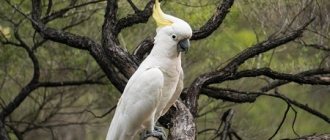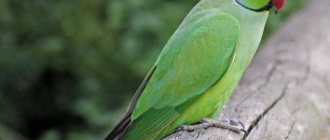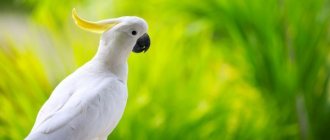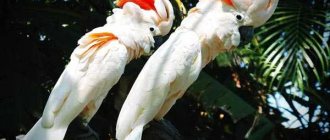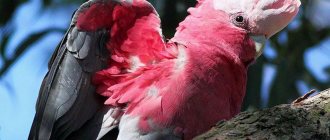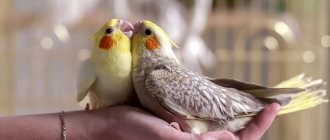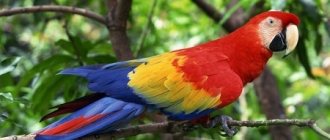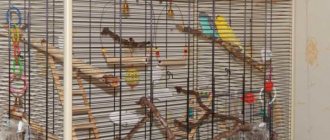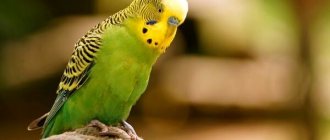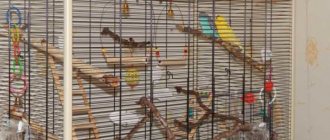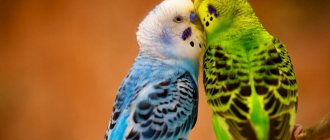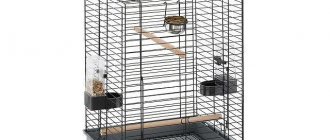Banks's mourning cockatoo does not have the most cheerful, but “telling” name. The black plumage of this bird resembles mourning clothes. British naturalist Joseph Banks noticed the magnificent parrots while traveling across the Australian continent. After the expedition around the world, drawings of exotic birds and their verbal representations have been preserved. In scientific classification, the mourning cockatoo is named after its discoverer, Sir Joseph Banks. You will find a description of a bewitchingly beautiful parrot, features of life in nature and captivity in this article.
Appearance
Banks' mourning cockatoo looks luxurious, like most members of this family. Parrots have clearly expressed sexual dimorphism. Males have glossy anthracite feathers, while females have a black color smoothed out with a brown tint, the tips of the feathers are decorated with a speckled milky pattern. Boys are distinguished by a wide horizontal stripe of red color on the inside of the tail. In girls, this area of plumage is in the form of alternating orange and black stripes.
This is interesting! Individuals of either sex up to four years of age have the same plumage as females. Only at the age of puberty do males develop a permanent color.
On the bird's head there is a mobile, lush crest, like all cockatoos. The gray beak is half-covered with a thick beard. Paws are dark gray. There is black, unfeathered skin around the eyes. The parrot's weight is 800-900 g, and its height is 65 cm. This is one of the largest representatives of the genus of mourning cockatoos. In total, there are 5 subspecies of Banks' cockatoo, which differ in size, beak shape, and habitat.
Life in nature
The cockatoo's homeland is mainland Australia. Sparse flocks of Banks' parrots are found throughout almost the entire continent. Birds with mourning plumage inhabit eucalyptus forests, tropical woodlands and savannas. They hide in the crowns of old, spreading trees from the merciless sun and stay there for the night. In dry times, when forest fires rage and water bodies dry up, parrots are forced to wander in search of better conditions.
Large Banks' cockatoos feed on a variety of nuts, fruits and seeds. Insects and larvae are also part of their diet. These birds rarely feed from the ground, as they fear attacks from predators. If a group of cockatoos dares to descend, one parrot is the first to go on a “reconnaissance” mission. Having found a territory with sufficient food, he loudly proclaims this, calling the flock to a feast. In the north of Australia, mourning cockatoos raid vegetable and cereal fields, destroying crops of corn, wheat, and root crops. Because of this, birds have developed a reputation as pests.
What does it eat?
The diet of Inca cockatoos is predominantly plant-based and in this way it is no different from the diet of other species of parrots. These birds actively eat:
- Tree seeds (primarily pine cones, acacia and eucalyptus seeds).
- Nuts (Almonds and pecans).
- Insect larvae.
- Cereal seeds (mainly corn and wheat).
- Roots of plants.
- Fruits and vegetables (They really like melons and wild figs).
- Flowers.
Habits, intelligence
In its natural environment, the mourning parrot's way of life is unhurried and calm. The birds spend most of the day in the upper tiers of the forest, moving from branch to branch. They do not fly very fast, and on the ground they move awkwardly, with a lazy gait. Cockatoos in a flock constantly call to each other, and when they notice danger, they make loud, unpleasant sounds. During the nesting season, fights and competition for females and territory may occur in the flock.
Parrots living in captivity do not express their instincts as clearly. For the most part, Banks' cockatoos are even-tempered. However, they can be aggressive, playful, bored, and sensitive. If a pair of cockatoos lives at home, the behavior of these birds is quite free and emotional. A lonely individual does not create much noise, but its wakefulness is accompanied by various sounds: creaking, clicking, grunting, whistling.
When an owner works with a pet, it shows its best qualities: tenderness, gentleness, friendliness. Mourning cockatoos love attention and eagerly respond to any initiative. They do not speak, but enjoy exploring their surroundings and having fun with available objects.
Note! You must not let your guard down when interacting with a parrot. The large cockatoo bird is quite dangerous - with its powerful beak it can cause serious injury.
How much does a cockatoo parrot cost in Russia?
If you do not have the opportunity to purchase this parrot abroad, then purchasing in Russia is an option. At the same time, the cost of cockatoos in Russia will, of course, be much lower than abroad.
How much does a cockatoo parrot cost in rubles? The most expensive option can be quite expensive (for example, Kakadu Inka can cost more than 700 thousand rubles). Of course, you can find an advertisement for the sale of cockatoos from private individuals and the price will be quite affordable - about 15-20 thousand rubles, but in this case you can easily stumble upon fraud. In addition, you may purchase a sick or elderly bird that may not live long, or a wild, untamed parrot that will be difficult to get along with.
| Parrot species | Approximate minimum cost in Russia |
| Goffin's cockatoo | 45,000 rub. |
| Pink Cockatoo | 55,000 rub. |
| Lesser yellow-crested cockatoo | 60,000 rub. |
| Solomonov Cockatoo | 60,000 rub. |
| Yellow-crested cockatoo | 100,000 rub. |
| White-crested cockatoo (Alba) | 120,000 rub. |
| Moluccan Cockatoo | 150,000 rub. |
| Spectacled Cockatoo | RUR 180,000 |
| Palm Cockatoo | 450,000 rub. |
| Cockatoo Inka | RUB 725,000 |
Conservation status of the species
The mourning cockatoo population is not currently in danger of extinction. Capturing and exporting outside the country, as well as hunting Banks' cockatoo, is prohibited by law. You can shoot only those birds that destroy crops, and then only with a license.
Gradual urbanization has led to a reduction in the areas where parrots can exist without fear. However, they are far from extinct. The population size is not increasing, but it is not decreasing at an alarming rate. Banks' Mourning Cockatoo is classified as Least Concern according to the Red Book.
What determines the cost of a cockatoo?
The cost of a cockatoo parrot depends on its place of birth, place of purchase, upbringing, species and age.
- Moluccan. Its price starts at $2,500. This is the most valuable breed, and therefore there is a lot of demand for it.
- Yellow-crested - $1,500.
- White-crested – $2,000.
- Goffin - 700-1000 dollars.
We looked at how much a cockatoo chick, about 5 months old, costs. How much will a talking cockatoo parrot cost? In this case, the price rises significantly and it all depends on the number of words and phrases that the parrot can pronounce, as well as on its skills. We do not recommend buying very old birds, as it will not be easy to get along with them.
Reproduction in the natural environment
Banks' parrots develop slowly - they reach sexual maturity in the fourth year of life. Obeying the instinct of reproduction, cockatoos mate and remain faithful to their partners until death.
The nesting season in Australia's warm climate begins when summer begins in the southern hemisphere and lasts from October to March. The closer to the equator the territory where Banks' mourning cockatoo lives, the more opportunities the parrots have to breed and feed their offspring. In the cool southern regions of the continent, bird breeding rates are reduced.
Mourning Banks' cockatoos next to a hollow
During mating games, the male and female behave funny: he spreads his crest and tail, stomps around in a circle, trying to impress his partner with his beauty. She enthusiastically watches the dances and, if she likes the boyfriend, begins to peck at him. This behavior means that the marriage union has developed. The female favorably accepts the male and mating occurs.
Future parents begin preparing the nest. To do this, they look for a suitable hollow in an old tree, line it with chopped branches, leaves, and dust. The female settles into the nest, lays 1 or 2 eggs and incubates them. She will sit on the eggs for a month, and during this time the male will bring her food. Occasionally the female has to leave the nest to drink.
Mourning cockatoo chick
The bird warms the clutch for 29-30 days and, finally, offspring appears in the nest. If both eggs are fertilized and each produces a chick, the parents will not be able to feed both. Most often, one chick from a brood is viable. He remains under care for several months, and then, having acquired the necessary skills, goes out into independent life.
Captivity
The mourning cockatoo is kept extremely rarely at home. This exotic bird is difficult to get, and it costs a lot. Not everyone can afford to become the owner of such a curiosity.
Overall, Banks' cockatoos are quite expensive to own. Before purchasing a valuable bird, you need to take care of its housing, diet, and treatment. In addition, it is necessary to provide an optimal microclimate in the apartment for a heat-loving parrot to live.
Aviary
For a grandiose bird, housing must be appropriate. A regular medium-sized cage is completely unsuitable. You will need a spacious enclosure, the minimum parameters of which are 1.5 m width, 2 m height, 3 m length. The walls of the enclosure are covered with thick wire mesh. Mourning cockatoos like to climb the mesh, clinging to the mesh with their beaks and claws. Aerobatics for them is to hold onto a support with their paws and hang upside down.
It is not recommended to install an aviary outdoors - low temperatures have a bad effect on exotic birds. In cool weather and at night, parrots will freeze, become fussy, and may even get sick. If the enclosure is located in an apartment, you need to frequently ventilate the room, but do not create drafts.
The inventory must be reliable and thorough, otherwise the parrot will destroy everything with its strong beak. Steel feeders are firmly fixed to the frame so that the bird does not knock them over. Natural untreated branches of deciduous trees are suitable as perches. Rough bark and hard wood help to naturally wear down the claws, which grow incredibly quickly in cockatoos.
On a note! You can bring the home atmosphere closer to the natural one with the help of branched driftwood, forming an intricate design from them.
Diet
Banks' cockatoos naturally eat seeds, nuts, berries and fruits. At home, you can feed your luxurious pets with ready-made formulas for large parrots.
Multi-component factory feeds contain the following ingredients:
- corn;
- sunflower;
- safflower;
- wheat;
- crushed and whole peanuts;
- barley;
- oats;
- buckwheat;
- millet.
You can combine seeds, grains and nuts in different ways, and compose compositions according to original recipes. It should be remembered that a large parrot eats 50 g of dry food per day, and this is only a third of the diet. The rest of the volume consists of greens, vegetables and fruits, and sprouts.
During the molting period, which happens 1-2 times a year in parrots, the food must be enriched with minerals and vitamins. Nutritional supplement is available in the form of powder, granules or drops. Many birds are afraid to swallow colored granules, so this method of fortification is not suitable for everyone. If the parrot calmly accepts manipulations, you can give it drops in its beak. Otherwise, another option remains - diluting liquid vitamins with water.
Where is the best place to buy
Where to look for a cockatoo parrot for home keeping? It depends on what purpose you want to purchase the bird for. If you plan to breed, it is better to take a couple of parrots from a nursery. This way you will get healthy purebred birds, albeit for a considerable amount.
If you need a beautiful and smart pet for companionship, you can search through the advertisements. However, in this case, there is a possibility of falling for resellers or scammers. It is best to join a club of similar interests and consult about purchases on amateur forums.
On a note! You should not go to a pet store or bird market to buy a cockatoo - they most often sell sick or illegally imported birds that have not been quarantined.
Breeding Features
It is difficult, but possible, to obtain offspring of mourning cockatoos at home. For successful breeding, a pair of birds is selected that get along well with each other. In addition, parrots should be well fed, healthy and active. Banks' cockatoos are ready to breed at the age of 4-5 years.
The reproductive instinct itself does not manifest itself properly in domestic parrots. Having set the goal of breeding, the owner takes stimulating measures:
- Gradually increases the duration of daylight hours to 14 hours.
- Brings the air temperature to 27-28 degrees, and humidity to 60%.
- Feeds future parents with sprouted grains and animal protein (eggs, cottage cheese, boiled meat).
- Introduces feeding into the diet for the nesting season.
- Installs a nesting box and a nesting house in the enclosure.
- Takes care of the peace of parrots and minimizes communication with them.
For mourning cockatoos to breed in captivity, they must be kept together from an early age. This is how the chicks become attached to each other, and not to humans, and do not lose their innate instincts.
The incredible beauty of Banks' cockatoo attracts and fascinates. A gorgeous bird with luxurious black plumage is not only an interior decoration, but also a source of pride. An expensive and capricious parrot needs careful care and attention. You can have such a pet at home only if you are prepared for enormous responsibility and considerable expenses.
Description
The cockatoo is a true giant even among other genera of parrots. Its body length can reach 60 cm! In addition, they are considered old-timers; they can live up to 100 years! If they are taken home as small chicks, they can outlive their owners.
And it doesn’t matter how much a cockatoo parrot costs - if you don’t have enough time to care for and communicate with it, then it’s better to refuse to purchase the bird. These pets require constant attention, and they will demand it with loud screams. But it is still necessary to devote a lot of time to the bird, because without your communication the bird will develop a nervous breakdown and begin to pluck its own feathers.
These birds are distinguished by their bright colors and incredible artistry. They can easily learn a large number of words, phrases and sentences, and their varieties differ in the color of their plumage and the length of their feathers.
